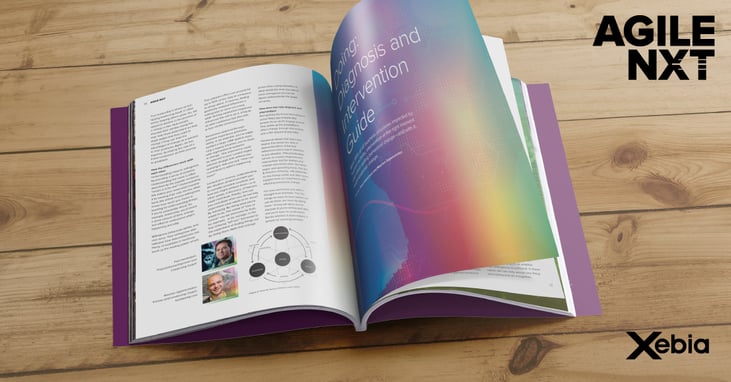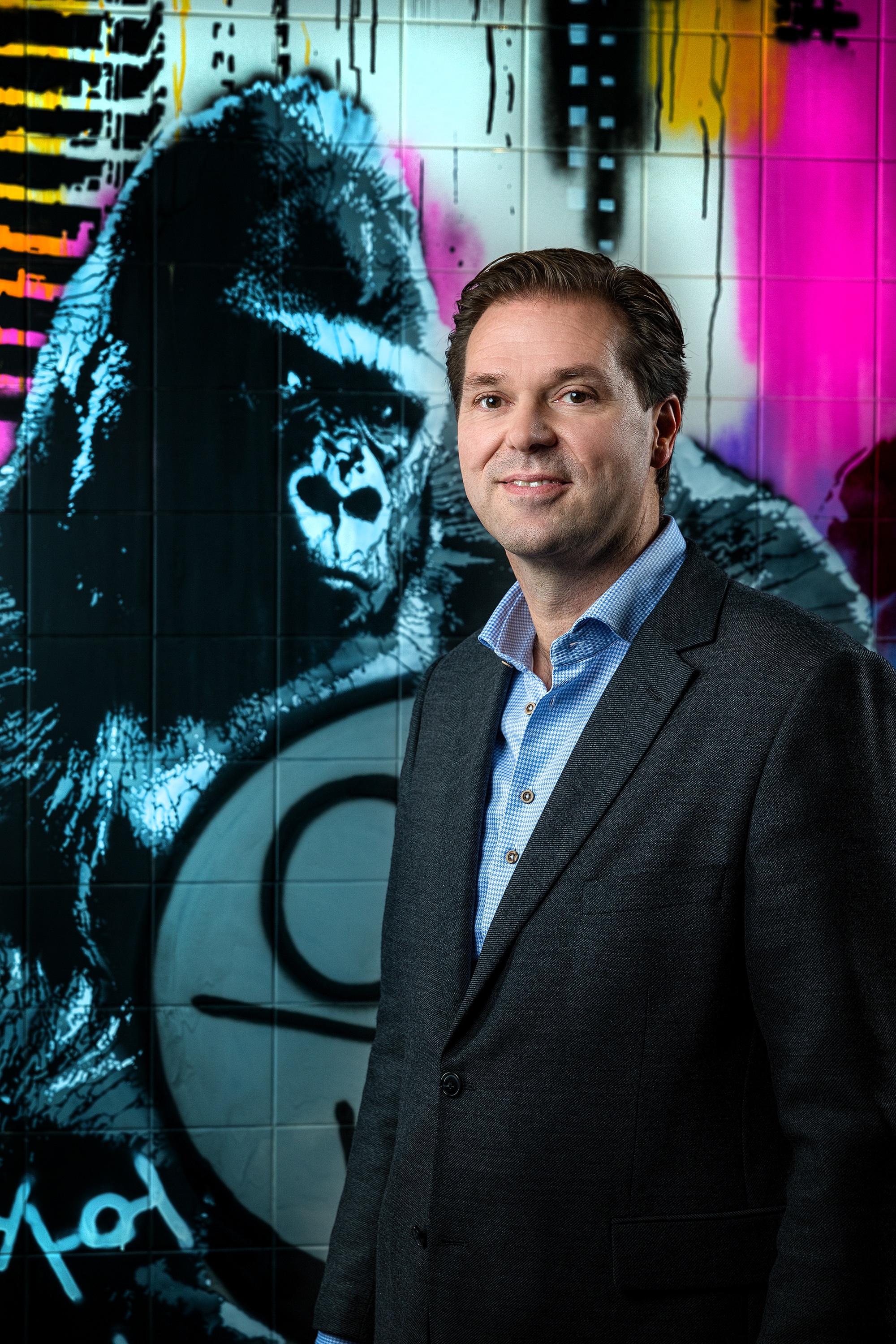With 95% of all business processes impacted by human activity, intervention at the right moment can elicit lasting behavioral change—and with it, organizational change.
Why don’t they just do as you tell them? You hate repeating yourself over and over again. Are they ignorant, arrogant, plain stubborn, loyal or obedient to others? Do they see things differently? You know that if people change the way they look at things, the things they look at change. So how can you influence the way they look at things?
This article is written by Paul Immerzeel and Maarten Uppelschoten.
This article is published in  . Agile NXT is the magazine full of inspiration for professionals on the emerging Agile journey. Theme of #2: New Insights for Agile Performance Management.
. Agile NXT is the magazine full of inspiration for professionals on the emerging Agile journey. Theme of #2: New Insights for Agile Performance Management.

We assume that you’re struggling with getting others to do what you want them to do or what you believe they should do. The art and practice of doing are easy to use and have explanatory power. It’s your time-saving guide to diagnosis and intervention in organizational change.
Human behavior determines performance and outcome. Whether it’s a new or established business, activities all along the value chain—from securing funding and production to marketing and sales—come down to the behavioral processes of intent and decision making. All businesses are run by people. What’s more, research has proven that engagement has a major impact on business results.
We believe at least 95% of all business activity is controlled by human behavior. Even in automated businesses, the algorithms powering organizational processes are created and regulated by humans. Therefore, it becomes crucially important to understand and influence those behaviors, particularly in organizational change processes.
The Doing model
Effecting lasting behavioral change is a process that goes beyond a single meeting or KPI goal-setting discussion. Based on our experience, we’ve designed a model to help you identify an individual’s current behavior and trigger intervention to accelerate the conduct that yields the desired outcome. In social psychology, the bridge between ability and willingness is understanding. Some may say urgency is more important than understanding, but our experience shows that if the urgency is not understood, the willingness (in most cases) remains absent. Even when people understand and are able to execute a job, they may not do so. This leads us to place “doing” in the middle, as, in the end, all our thoughts and decisions lead to doing something or not doing something.
This “Doing: Diagnosis and Intervention Guide” attempts to explain why people do things, how intervention triggers the behavior that creates the desired outcome—and with it, organizational change.
What influences doing?
Three forces (and a fourth hidden one) impact doing or action, as we see in Figure 1. These influencers are “understanding,” “willing,” and “able” (we use the verb forms to emphasize the sense of action). The hidden force is enabled. Each influencer not only has an independent impact on action but also works in collaboration with the other forces.
Understanding
Understanding, or attributing meaning to something, is the result of experiencing events through previous frames of reference. We often see participants in training workshops who are uncomfortable until they are given an agenda of the day’s activities—knowing what’s to come enables them to recognize the potential value and gives them a sense of control when it comes to deciding if they want to participate or not.
Willing
Willing, or being eager to do something, comes from motivation. In behavioral psychology, (extrinsic) motivation is often associated with reward learning. As the American psychologist B.F. Skinner explained, your behavioral response to a stimulus is strengthened by a positive reinforcement by way of a reward, or because your response avoids the pain of a negative consequence (negative reinforcement). Either way, the wanted behavior is reinforced and therefore is more likely to be repeated, which is exactly the goal of our model. Simply put, if you want to do something, you are very likely to engage in the activity.
Willingness either comes from within, based on intrinsic beliefs, values and sense of purpose and belonging, or it is triggered externally. Please note that externally triggered behaviors can become automatized and habitual, thus changing from extrinsic to intrinsic by internalization. Also, the underlying mechanisms which lead to willingness, are largely subconscious and can be influenced heavily, for example by nudging.1 Remember, we might think that homo sapiens’ behavior is rational but in many situations, humans are predictably irrational. Feelings often influence our decision making much more than we might realize. This makes willingness a complicated influencer of doing, not to be underestimated. Yet the good news is that this influencer can be influenced.
Able and being enabled
Being able and feeling enabled are the combined third and fourth influencers of doing. Believing you currently have the ability to do something or that you can grow the needed skills or craftsmanship is an important determinant to engagement. Feeling enabled, on the other hand, refers to the degree to which you believe the organizational ecosystem lets you do your job. Does it support your actions, or does it box you in?
Shockingly, when people are asked to score themselves over the four influencers, 95% mark themselves highly on being able, understanding and willing. Even in management teams, however, the feeling of being enabled is always scored somewhere between low and poor. Yet, on the other hand, it's not that shocking. If people can use the “self-serving bias” they will.
In reverse: how doing influences its influencers
We also observe that people are unsure about whether they truly understand something, whether they are able to do it, or whether their willingness is sufficient. In these cases, we can only advise one thing: start doing and do it together. True leadership is aimed at multiplying leadership itself; in other words: helping others grow. So, our appeal to leaders in the process of a change is this: help people discover their abilities along the way; help them understand so they might realize that they want to change if they can map the advantages of change as a solution to their problems. Again, do this together, by playing the role of a travel companion on their journey to greatness.
How the influencers work with each other
Understanding impacts willingness by providing a sense of purpose. Understanding the value is often described by the popular sentence “what’s in it for me?” Understanding this makes your mind work towards it by wanting it (or not). On the other hand, the extent of your willingness shows how much you invest in(wanting to) understanding things. If you’re passionate about, for example, leadership, you’ll invest a great amount of time, energy and effort to understand what’s happening and why.
Willingness influences ability, and vice versa. Your willingness also indicates how determined you are. Plenty of examples in medicine teach us the healing power of will. This placebo effect can account for up to 50% of the cure as compared to drugs alone. In reverse, feeling positively enabled influences a willingness to carry out a task, while feeling obstructed negatively influences the will to do it. It has to do with confidence but also with(a fear of) the consequences.
Awareness acquired through previous experience promotes ability. If, for example, you’ve implemented a large CRM system replacing a legacy situation, you’ve dealt with organizational behavior in change. This experience could be relevant to your current organizational change task without you realizing it. Ask yourself, “How can I contribute to what’s happening here?”
Looked at in reverse, understanding the situation at hand prompts you to consider possible solutions and how you might achieve them—or in other words, a discovery of how you could contribute. Finally, how can you contribute when you do not fully understand what needs to be done? By following. By doing what you’re asked to do. The sense of “loss of control” can be overcome by trust, for example, or by courage, or the fear of being “left out.” Surrender to the experiment of finding things out by doing them. Note that courage grows when caring intensifies. In other words the more you care to more courageous you can be. Never underestimate the power of caring.
How does this help diagnosis and intervention?
Recognizing the forces that influence action helps you analyze why people do (or don’t) engage at work. This opens up the possibility to affect change through intervention with a fair amount of precision.
Feedback shows that users who deploy this model are able to determine which of the four influencers need urgent attention in any situation. This prioritization serves as a quick diagnosis and intervention tool for leaders and change specialists alike. Our white paper and upcoming book, The Art & Practice of Doing, will elaborate on the Doing model and offer more insights from our experience with effecting behavioral change.
For now, we’ll leave you with a thought from Aristotle: “For the things we have to learn before we can do them, we learn by doing them.” Doing will allow you to discover if you’re willing and able, and you’ll learn to understand. But be warned: It does require a growth (or learning) mindset.
Doing: Diagnosis and Intervention
An example of how it works: Peter is a team member who has not invested any effort in the new change because he’s seen many changes in the past that he feels have had no concrete results.
His fixed mindset indicates a lack of willingness born from previous experience. Engage with Peter by discussing his skepticism and his organizational pains and work with him to find a solution. If you’re successful, chances are that Peter will come around and engage with the change. If not, he may become further disengaged and even alienated, which could lead to skills redundancy. Outlining these consequences may work as a second attempt to incite behavioral change. Some may argue that this requires using fear tactics, but those familiar with the concept of dominant opinions in communities know that a dissident or antagonist position can be valuable due to the variation in opinions and options. On the other hand, persistance of resistance might prevent growth of a movement. So, at a certain moment in time there’s a tipping point needed: either agree or disagree, but commit — or find another tribe.
Want to know more about this topic? Download  agilenxtmagazine-new-insights-for-effective-agile-performance-mng and start your personal change tomorrow.
agilenxtmagazine-new-insights-for-effective-agile-performance-mng and start your personal change tomorrow.






